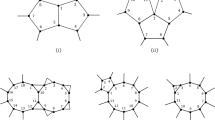Abstract
Graph fall-coloring, also known as idomatic partition or independent domatic partition of graphs, was formally introduced by Dunbar, Hedetniemi, Hedetniemi, Jacobs, Knisely, Laskar and Rall in 2000 as an extension of both Graph Coloring and Graph Domination. It asks for a partition of the vertex set of a given graph into independent dominating sets, or equivalently into maximal independent sets. We study two fundamental questions related to this concept: when such a partition of vertices can exist, and how it relates to a proper coloring. We construct graphs with a large number of possible fall-colorings and as a consequence of that we answer a question of Dunbar et al. (J Combin Math Combin Comput 33:257–273, 2000) by constructing a family of graphs with arbitrarily far apart chromatic number and fall-chromatic number. In fact, we construct graphs whose Fall set (collection of k such that the graph has a fall coloring with k colors) is an arbitrarily long arithmetic sequence, thus giving us graphs with Fall set of large order having large gaps between its elements. We give a sufficient condition on the minimum degree for fall-colorable graphs and characterize the sharpness of this bound. Related to this, we also construct families of graphs which have both a k-fall-coloring and a k-coloring that is not a fall coloring for every k, illustrating the complex relationship between idomatic and non-domatic independent partitions.
Similar content being viewed by others
References
Allan, R.B., Laskar, R.: On domination and independent domination numbers of a graph. Discr. Math. 23, 73–76 (1978)
Berge, C.: Theory of Graphs and its Applications. Methuen, London (1962)
Bollobás, B.: Extremal Graph Theory. LMS Monographs, vol. 11. Academic Press, London (1978)
Cockayne, E.J., Hedetniemi, S.T.: Disjoint independent dominating sets in graphs. Discr. Math. 15, 213–222 (1976)
Cockayne, E.J., Hedetniemi, S.T., Miller, D.J.: Properties of hereditary hypergraphs and middle graphs. Can. Math. Bull. 21, 461–468 (1978)
Crescenzi, P., Kann, V., Karpinski, M.: A compendium of NP optimization problems. http://www.nada.kth.se/~viggo/wwwcompendium/. Accessed 27 Mar 2019
Dunbar, J.E., Hedetniemi, S.M., Hedetniemi, S.T., Jacobs, D.P., Knisely, J., Laskar, R.C., Rall, D.F.: Fall colorings of graphs. J. Combin. Math. Combin. Comput. 33, 257–273 (2000)
Erdős, P., Hobbs, A.M., Payan, C.: Disjoint cliques and disjoint maximal independent sets of vertices in graphs. Discr. Math. 42(1), 57–61 (1982)
Goddard, W., Henning, M.A.: Independent domination in graphs: a survey and recent results. Discr. Math. 313(7), 839–854 (2013)
Greenwell, D., Lovász, L.: Applications of product coloring. Acta Math. Acad. Sci. Hungar. 25, 335–340 (1974)
Haynes, T.W., Hedetniemi, S.T., Slater, P.J.: Fundamentals of Domination in Graphs, pp. 67–106. Marcel Dekker, New York (1998)
Harutyunyan, A., Horn, P., Verstraete, J.: Independent Dominating Sets in Graphs of Girth Five, Combinatorics, Probability and Computing, to appear
Henning, M.A., Löwenstein, C., Rautenbach, D.: Remarks about disjoint dominating sets. Discr. Math. 309(23–24), 6451–6458 (2009)
Kaul, H., Mitillos, C.: On graph fall-coloring—operators and heredity. J. Combin. Math. Combin. Comput. 106, 125–151 (2018)
Karp, R.M.: Reducibility among combinatorial problems. In: Miller, R.E., Thatcher, J.W., Bohlinger, J.D. (eds.) Complexity of Computer Computations. The IBM Research Symposia Series. Springer, Boston, MA (1972)
Klavžar, S., Mekiš, G.: On idomatic partitions of direct products of complete graphs. Graphs Combin. 27(5), 713–726 (2011)
Lyle, J., Drake, N., Laskar, R.: Independent domatic partitioning or fall-coloring of strongly chordal graphs. Congr. Numer. 172, 149–159 (2005)
Laskar, R., Lyle, J.: Fall coloring of bipartite graphs and cartesian products of graphs. Discr. Appl. Math. 157(2), 330–338 (2009)
Valencia-Pabon, M.: Idomatic partitions of direct products of complete graphs. Discr. Math. 310(5), 1118–1122 (2010)
Valencia-Pabon, M.: On some problems on idomatic partitions and b-colorings of direct products of complete graphs. Math. Contemp. 39, 93–100 (2010)
West, D.B.: Introduction to Graph Theory. Prentice Hall Inc., Upper Saddle River (1996)
Author information
Authors and Affiliations
Corresponding author
Additional information
Publisher's Note
Springer Nature remains neutral with regard to jurisdictional claims in published maps and institutional affiliations.
Rights and permissions
About this article
Cite this article
Kaul, H., Mitillos, C. On Graph Fall-Coloring: Existence and Constructions. Graphs and Combinatorics 35, 1633–1646 (2019). https://doi.org/10.1007/s00373-019-02082-7
Received:
Revised:
Published:
Issue Date:
DOI: https://doi.org/10.1007/s00373-019-02082-7




